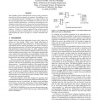Free Online Productivity Tools
i2Speak
i2Symbol
i2OCR
iTex2Img
iWeb2Print
iWeb2Shot
i2Type
iPdf2Split
iPdf2Merge
i2Bopomofo
i2Arabic
i2Style
i2Image
i2PDF
iLatex2Rtf
Sci2ools
DAC
1996
ACM
1996
ACM
Pseudorandom-Pattern Test Resistance in High-Performance DSP Datapaths
The testability of basic DSP datapath structures using pseudorandom built-in self-test techniques is examined. The addition of variance mismatched signals is identified as a testing problem, and the associated fault detection probabilities are derived in terms of signal probability distributions. A method of calculating these distributions is described, and it is shown how these distributions can be used to predict testing problems that arise from the correlation properties of test sequences generated using linear-feedback shift registers. Finally, it is shown empirically that variance matching using associativity transformations can reduce the number of untested faults by a factor of eight over variance mismatched designs.
Computer Architecture | DAC 1996 | Signal Probability Distributions | Variance Mismatched Designs | Variance Mismatched Signals |
| Added | 08 Aug 2010 |
| Updated | 08 Aug 2010 |
| Type | Conference |
| Year | 1996 |
| Where | DAC |
| Authors | Laurence Goodby, Alex Orailoglu |
Comments (0)

